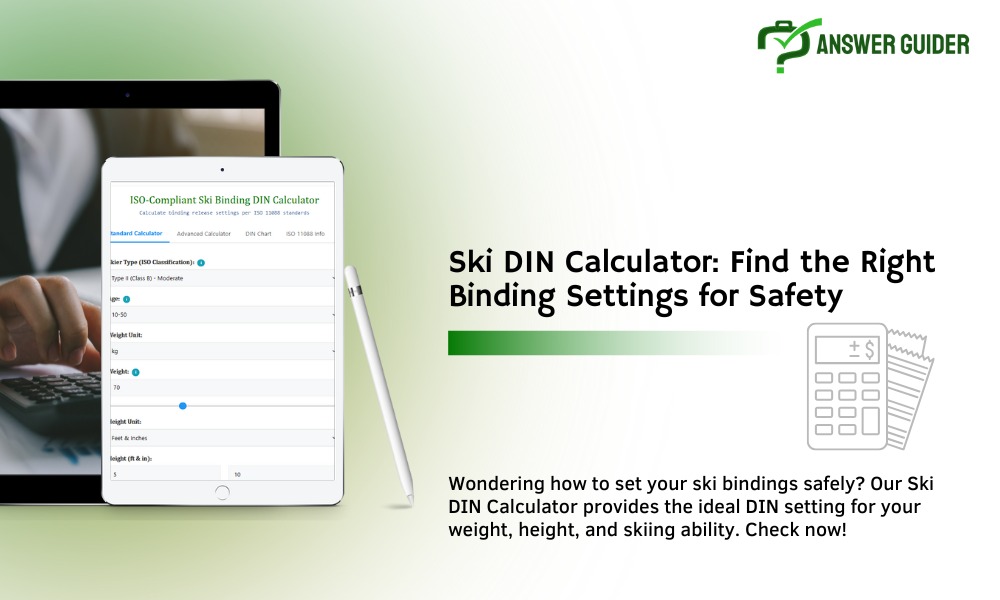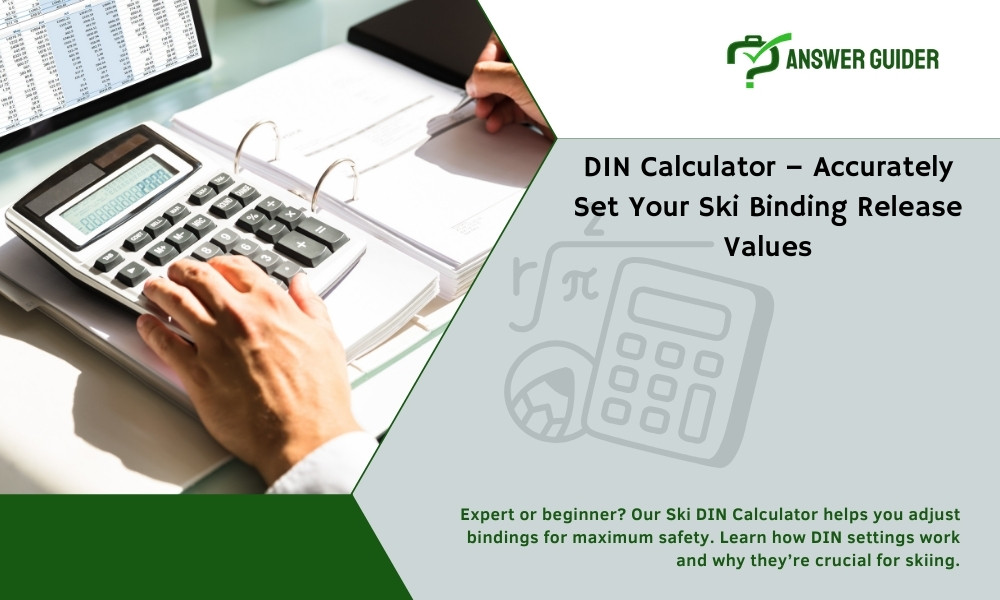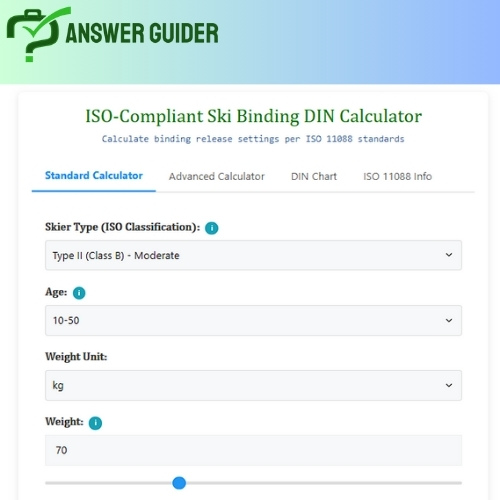Contents
When it comes to skiing, safety should always be a top priority. Our Ski DIN calculator helps you to find the correct DIN value, ensuring that your ski bindings release when they should—and stay put when needed. Whether you’re a seasoned skier or a first-time snow adventurer, one of the most crucial safety aspects of your gear setup is your DIN setting. Setting the correct DIN value ensures your skiing safety.
ISO-Compliant Ski Binding DIN Calculator
Calculate binding release settings per ISO 11088 standards
Recommended DIN Setting
Skier Type: Type II (Moderate)
Weight: 70 kg
Height: 5'10"
Boot Sole Length: 300 mm
ISO 11088 Safety Note: This calculator provides ISO-compliant recommendations. DIN settings must be verified and adjusted by a certified ski technician using proper equipment. Improper binding settings can lead to serious injury. The International Organization for Standardization requires professional inspection of all binding settings before use.
Advanced DIN Recommendation
Base DIN: 4.5
Ability Adjustment: +0.5
Style Adjustment: +0.0
Final DIN: 5.0
This advanced calculation includes adjustments based on skiing style and experience.
ISO 11088 Safety Note: This calculator provides ISO-compliant recommendations. DIN settings must be verified and adjusted by a certified ski technician using proper equipment. Improper binding settings can lead to serious injury. The International Organization for Standardization requires professional inspection of all binding settings before use.
Standard DIN Chart Reference (ISO 11088 Based)
| Weight (lbs) | Type I (Class A) | Type II (Class B) | Type III (Class C) |
|---|---|---|---|
| 22-33 | 0.75 | 0.75 | 0.75 |
| 34-44 | 0.75 | 1 | 1.5 |
| 45-56 | 1 | 1.5 | 2 |
| 57-68 | 1.5 | 2 | 2.5 |
| 69-81 | 2 | 2.5 | 3 |
| 82-94 | 2.5 | 3 | 3.5 |
| 95-108 | 3 | 3.5 | 4 |
| 109-123 | 3.5 | 4 | 4.5 |
| 124-139 | 4 | 4.5 | 5 |
| 140-156 | 4.5 | 5 | 5.5 |
| 157-174 | 5 | 5.5 | 6 |
| 175-193 | 5.5 | 6 | 6.5 |
| 194-213 | 6 | 6.5 | 7 |
| 214-236 | 6.5 | 7 | 7.5 |
| 237-260 | 7 | 7.5 | 8 |
| 261+ | 7.5 | 8 | 8.5 |
ISO 11088 Note: This chart follows the ISO standard for binding release values. Actual settings may vary based on height, boot length and other factors. The ISO standard specifies that settings should be verified by a certified technician.
ISO 11088:2018 Standard Information
ISO 11088:2018 is the international standard for the assembly, adjustment, and inspection of alpine ski/binding/boot systems. It specifies:
- Guidelines for selecting proper equipment
- Methods for determining release torque values
- Procedures for adjusting binding release settings
- Safety requirements for binding performance
Key Components of the Standard
| Component | ISO Requirement |
|---|---|
| Skier Classification | Defines 3 types (I, II, & C) based on skier style and ability |
| Release Values | Specifies torque values for forward lean and heel release |
| Boot Sole Length | Requires precise measurement in millimeters for setting calculation |
| Age Adjustments | Specifies reduced settings for children under 10 and adults over 50 |
| Testing | Mandates specific test procedures for testing verification |
ISO Skier Type Definitions
Type I (Class A)
- Cautious skiing style
- Slow to moderate speeds
- Skis on groomed easy slopes
- Low speed controlled turns
Type II (Class B)
- Moderate skiing style
- Skis at moderate to high speed
- Skis on groomed slopes
- Uses parallel turns most of the time
Type III (Class C)
- Aggressive skiing style
- Fast speeds on difficult terrain
- Seeks jumps and demanding conditions
- High performance turns
ISO Binding Setting Formula
The ISO standard provides a formula for calculating release settings:
DIN = (weight * C1) + (height * C2) + (skier_type * C3) + (age * C4)
where:
- weight coefficient (C1 varies by kg)
- height coefficient (C2 varies by cm)
- skier_type coefficient (C3 per type level)
- age_factor coefficient (C4 based on age)
This scale is then adjusted for boot sole length and age factors.
ISO Compliance Notice
This calculator follows ISO 11088 guidelines but cannot replace professional binding adjustment. The standard requires:
- Settings must be verified by certified personnel
- Settings must be tested with torque measuring devices
- Binding function must be tested annually
- Any binding over 5 years old should be inspected
What Is a Ski DIN Setting?
In skiing, the term DIN means the tension release setting of your ski bindings. Though it stands for Deutsches Institut für Normung, the German Institute for Standardization.
Every skier knows how bruising falls can be. This ski setting is extremely important for:
- Preventing injuries to knees and legs due to high-impact falls
- Maintaining proper scaling on bindings that are secure at high speeds but on steep slopes prone to accidents
- functioning irrespective of the set riding conditions. The range of the skier’s knees is 0.75 to 18 or higher, depending on the binding. The higher the beefy number, the harder it gets to release, which, with some heavy, aggressive skiers, is handy.
What is the Importance of a Ski DIN Calculator?
A Ski DIN Calculator saves time and effort. Instead of manually interpreting complex charts, the calculator determines your ideal setting based on the industry benchmarks in seconds. Guessing is eliminated.
A good DIN calculator considers the following:
- Weight
- Height
- Skiing ability level (Beginner, Intermediate, Advanced, Expert)
- Ski boot sole length (in millimeters)
- Age (particularly for older skiers since 50, where often a lower DIN is recommended)
Your metrics and skiing style are fed into the calculator, which balances safety and performance to provide a suitable DIN value.

How to Use Our Ski DIN Calculator (ISO 11088 Standard)
Our Ski DIN Calculator ensures your bindings release correctly, reducing injury risk. Follow these steps to find your ideal DIN setting based on the ISO 11088 standard:
Step 1: Select Your Skier Type (ISO Classification)
- Type I (Class A) – Beginner skis cautiously on groomed runs.
- Type II (Class B) – Intermediate, moderate speed and varied terrain.
- Type III (Class C) – Advanced/Expert, aggressive skiing, off-piste, or racing.
- Example: For recreational skiing, select Type II (Class B).
Step 2: Enter Your Age
- Input your age in years.
- Note: Skiers under 10 or over 50 may have adjusted DIN ranges for safety.
Step 3: Input Weight & Height
- Weight: Enter in kg or lbs (toggle unit if needed).
- Height: Choose between cm or feet/inches.
- Example: For a 70 kg (154 lbs), 5’10” skier, input:
- Weight: 70 (kg)
- Height: 5 (ft) and 10 (in)
Step 4: Boot Sole Length (BSL)
- Measure the length of your ski boot sole in millimeters (printed on the boot).
- Common BSL: Men 295–350mm | Women 265–320mm.
- Example: Enter 300 mm.
Step 5: Choose Skiing Conditions (Optional)
Some calculators offer adjustments for:
- Recreational Setting: Standard DIN for groomed runs.
- Powder Day Setting: Slightly higher DIN for deep snow resistance.
Step 6: Calculate DIN
- Click “Calculate DIN (ISO 11088)” to generate your recommended setting.
How Does a Ski DIN Calculator Work?
A Ski DIN Calculator uses key factors such as:
- Skier Type (Ability Level) – Beginner, Intermediate, Advanced, or Expert.
- Height & Weight – Heavier and taller skiers typically need higher DIN settings.
- Age – Younger skiers (under 10) and older (50+) may have adjusted settings.
- Boot Sole Length (BSL) – The length of your ski boot in millimeters.
The calculator provides a recommended DIN range for your ski bindings by inputting these details.

Conclusion
The appropriate DIN setting can be the difference between a safe day on the snowy slopes and a day filled with pain due to possible injuries. We developed Ski DIN’s Calculator to help streamline the process and provide you with a quick, customized output, all based on proven industry standards.
Best of all, it’s free! Access it before your next ski trip, and don’t forget to help your fellow skiers ride safer, too.
Grab your personalized recommendations in under a minute now – ski smarter and ski safer.
Also, You can use those calculators:
Free Baby Eye Color Calculator – Predict Baby Eye Color
Free BTZ Calculator for Air Force Promotions
Free Chiron Calculator | Find Your Astrological Insights
Destiny Matrix Calculator – Fast, Insightful & Easy Use
Window Replacement Cost Calculator: Estimate Your Budget
FAQ
DIN Calculator App?
Yes, mobile apps are available to help you calculate DIN settings on the go. However, many apps lack full customization or recent binding standards. For the most accurate and updated results, we recommend using our free online Ski DIN Calculator, which works seamlessly on desktop and mobile devices.
Kids DIN Calculator?
Kids require lower DIN settings due to their lighter weight and lower force output. Our calculator includes child-specific options and guidelines to ensure safe release values based on a young skier’s weight, height, and boot sole length. Always verify results with a certified ski technician.
Best Skiing DIN Calculator?
The best skiing DIN calculator is easy to use, accurate, and based on official industry standards. Our Ski DIN Calculator was built with all of these in mind. It factors in weight, height, ability level, boot sole length, and age for a precise recommendation you can trust.
Marker DIN Chart 2024?
The 2024 Marker DIN chart provides reference values for skiers using Marker bindings. While useful, these charts can be complex to read manually. Our calculator applies the same industry-standard formulas found in charts like Marker’s—automating the process for faster and safer results.
Salomon DIN Chart?
Salomon’s DIN chart follows ISO 11088 standards for ski binding settings. Instead of manually interpreting it, use our Ski DIN Calculator, which applies those guidelines digitally to give you a reliable DIN setting for Salomon or any other compatible bindings.
Look Binding DIN Chart?
Like many others, look bindings follow a DIN chart format for setting release values. Our calculator simplifies this by using official chart data to deliver a fast, easy-to-read DIN value based on your details. It’s ideal for use with Look bindings and more.

